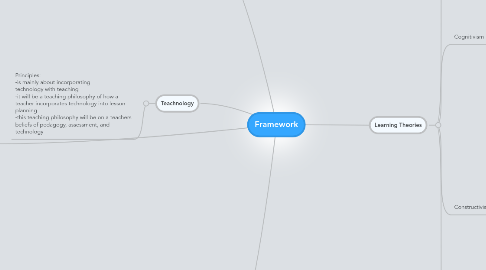
1. Connections between theories
1.1. -Each theory has a place for students to learn through technology. -Connectivism and Constructivism are similar in that they both allow students to either on their own or through other students gather information as a way to learn -Behaviourism and cognitivism both involve a lot of practice to retain information
1.2. -between SCOT and media ecology, technology is the most important factor in the study of these two ideas -Constructivism and Media Ecology relate in the scence that they are both actively engaging with their environment
2. Technology Theories
2.1. Media Ecology: -it is the study of media environments -environments are complex communication systems -how media of communication affects human perception, understanding, feeling and value -technology influences humans and society -studying the environments and the impact it has on people Implications on Education: -with all the technology out in the world, our students and teachers are influenced by it -teachers will try new technology as a way to better help their students learn whether the students know this piece of technology or not -students find new types of technology that they will use socially or academically -with the technology out there teachers and students will use it and it will impact them
2.2. SCOT (Social Construction of Technology): -technology doesn't determine human action but human action shapes technology -acceptance or rejection of technology should look to the social world Implications on Education: - if a student were to explore a website that they liked, they would tell there friends(other students) and most likely those kids would start using it too. This shows how human action shapes technology. -within the classroom there will be some sites students will want to use because others have used it before and they know it -as a teacher it is our job to use these sites in a way our students can learn from them
3. TPACK
3.1. Principles: -this is where teaching and technology will combine -there are three domains: a)TK (technology knowledge), knowing about technology b)CK (content knowledge), knowing about content matter c)PK (pedagogical knowledge), knowing how to teach -within these three domains there are 3 more: a)TP (technological pedagogy), how to teach using technology b)TC (technological content), when using technology the content needs to be relevant c)PC (pedagogical content), knowing how to teach the content. -TPACK is very much about how a teacher can fully integrate technology into the content they are supposed to teach and how to teach using technology.
4. Teachnology
4.1. Principles: -is mainly about incorporating technology with teaching -it will be a teaching philosophy of how a teacher incorporates technology into lesson planning -this teaching philosophy will be on a teachers beliefs of pedagogy, assessment, and technology
5. Learning Theories
5.1. Behaviourism
5.1.1. Principles: -conditioning (environmental stimulus re-applied -practice, practice, practice -operant conditioning (encourage positive reinforcement) -negative reinforcement -rewards given -teacher-directed instruction
5.1.2. Implications for Education: -when students are rewarded for accomplishing a task they will more than likely continue to do it -when students are learning a new concept practicing it over and over will make them understand it better -the instruction is very teacher-based which is more of a lecture-based teaching style -within the classroom the teacher would be doing a lot of modelling, cuing and shaping to teach the students
5.2. Cognitivism
5.2.1. Principles: -the mind is like a computer -we have a memory system in our brain -we build on what we already know -do some practice for greatest retention -there is an over or under-load theory (there can be too much information being presented, or not enough which makes it over or under stimulating) -the instructional design of information is important to how we learn -how things are organized
5.2.2. Implications for Teaching: -when building on to a concept already learned make sure to discuss that previously learned information and then build on it with new information -students need to have a balance between how their brains are stimulated, don't provide too much information on the smartboard, let them take in the important information first and continue to build off of that slowly -using prezi and powerpoints is great for stimulating the students because it is a different resource and it still is set up in a simple way
5.3. Constructivism
5.3.1. Principles: -we learn when we actively engage with our environment -start with the complex problems, then teach the skills to solve those problems -meets the needs of every students learning styles -majority of the time is spent working out these problems in groups -problem-based/project-based learning
5.3.2. Implications for Education: -students can work together collaboratively -discovery learning (students explore together or on their own) -students can create their own knowledge through problem solving with others
5.4. Connectivism
5.4.1. Implications for Education: -there are so many different resources online that students can access to continually find information -students can find out current information through twitter, email, any type of social networking really -supplying students with ipads, computers etc is beneficial for this learning theory -as a teacher, one should use these resources online when teaching students so they see first hand how it is used
5.4.2. Principles: -for the digital age -knowledge is formed by actions and experiences -build a network of knowledge sources and access them whenever you need them -the capacity to know more is more critical than what is currently known -keep and nurture those connections -knowing where to find the information is very important for this theory -MOOC
